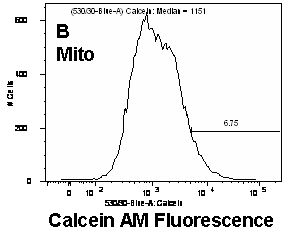Mitochondrial Permeability Transition Pore
The mitochondrial permeability transition pore is a nonspecific pore formed from the inner and outer mitochondrial membranes which occurs during the apoptotic process. The opening of the MPTP results in the swelling of the mitochondria and allows proteins of <1500 Daltons to pass from the mitochondria to the cytosol e.g. cytochrome c and Apoptosis Inducing Protein (AIF).
The opening of the MPTP during apoptosis results in an excess build up of calcium in the organelle and increased levels of ROS (Reactive Oxygen Species). Increased permeability of the MPTP results in the loss of mitochondrial membrane potential and of cytochrome c.
The opening of the mitochondrial transition pore can be measured by flow cytometry. Cells loaded with Calcein AM (and quenched with Cobalt Chloride) after induction of apoptosis can be compared to that found in untreated cells. Calcein fluorescence leaks out of mitochondria when MPTP is open resulting in reduced fluorescence.
Protocols:- MPTP assay

